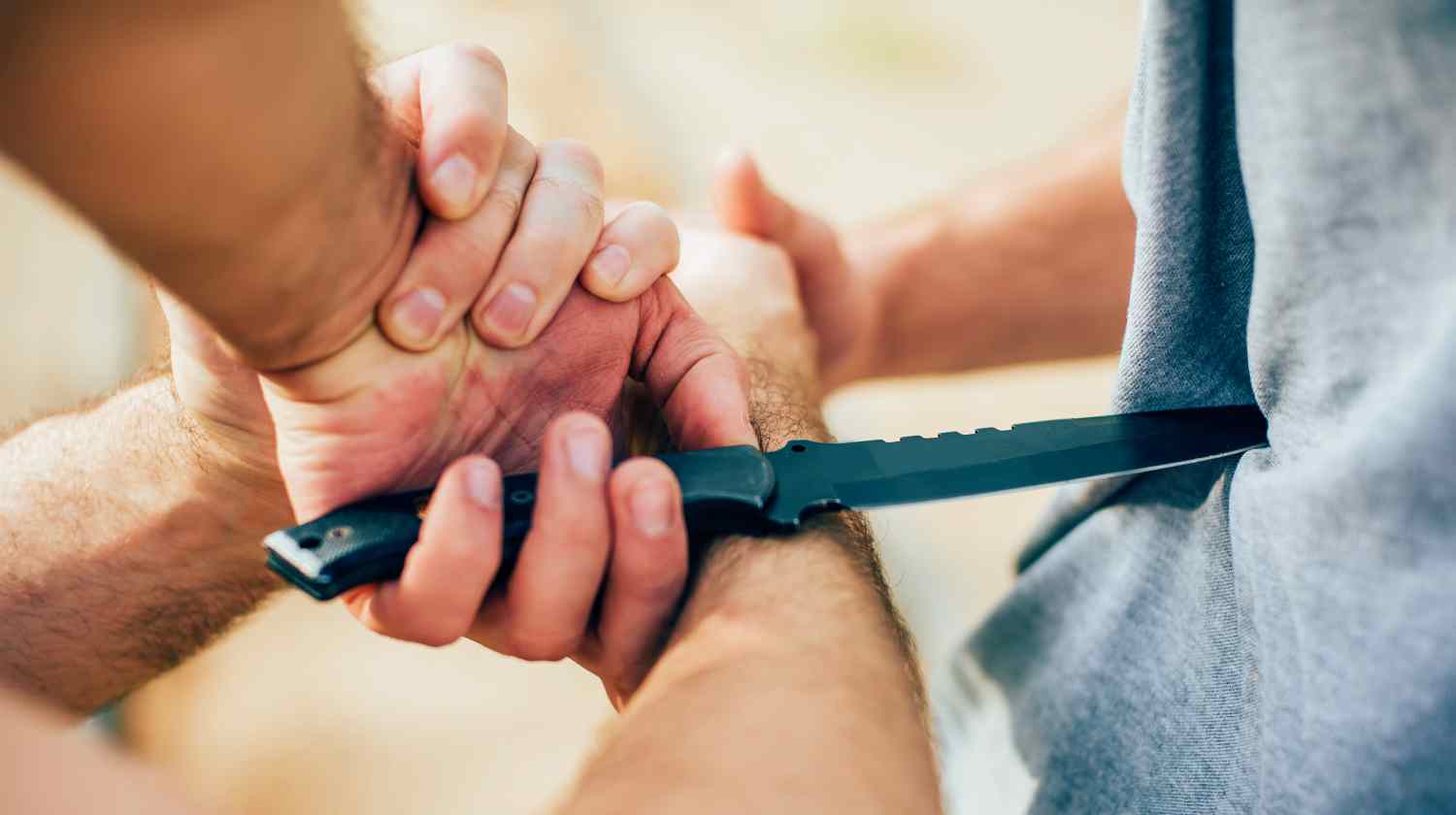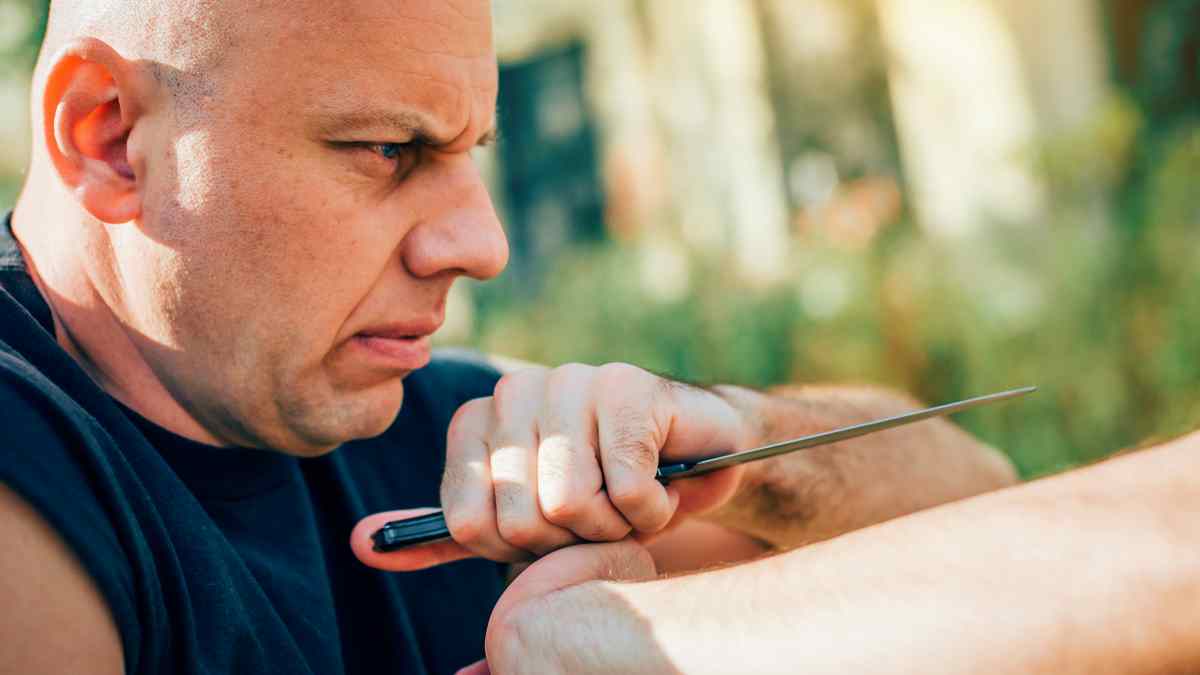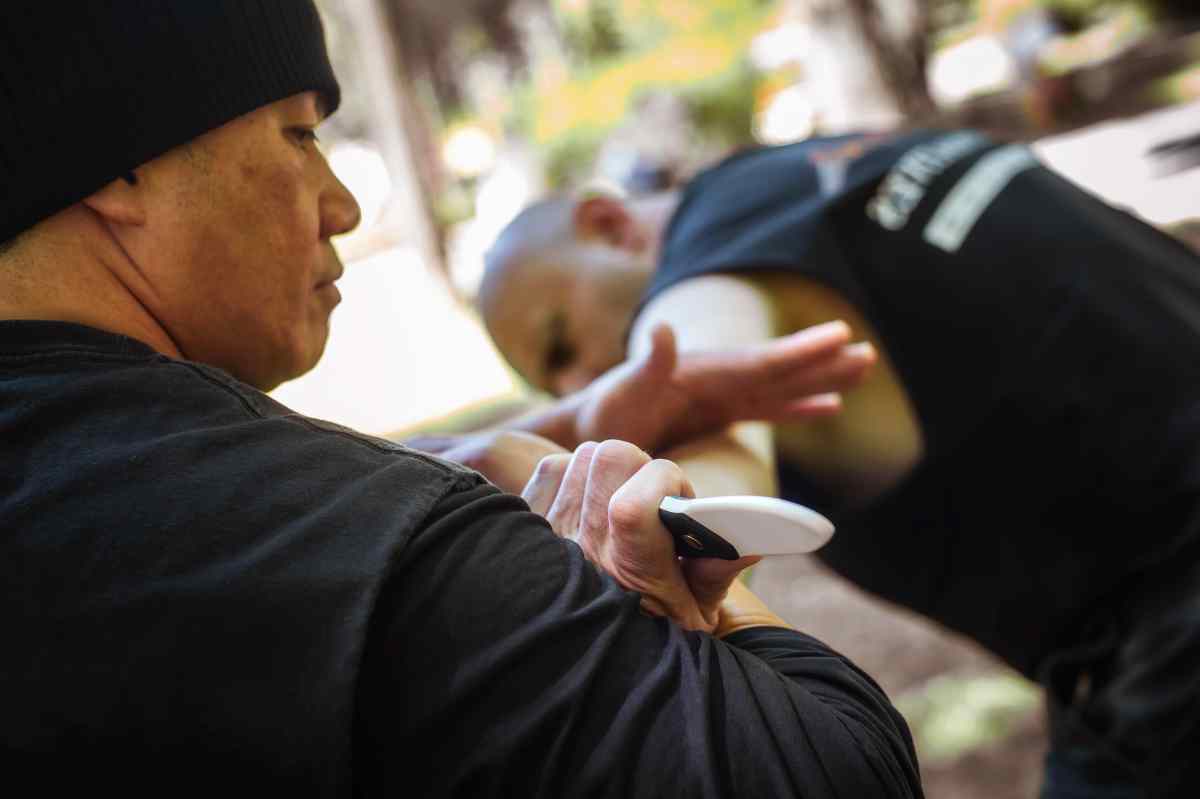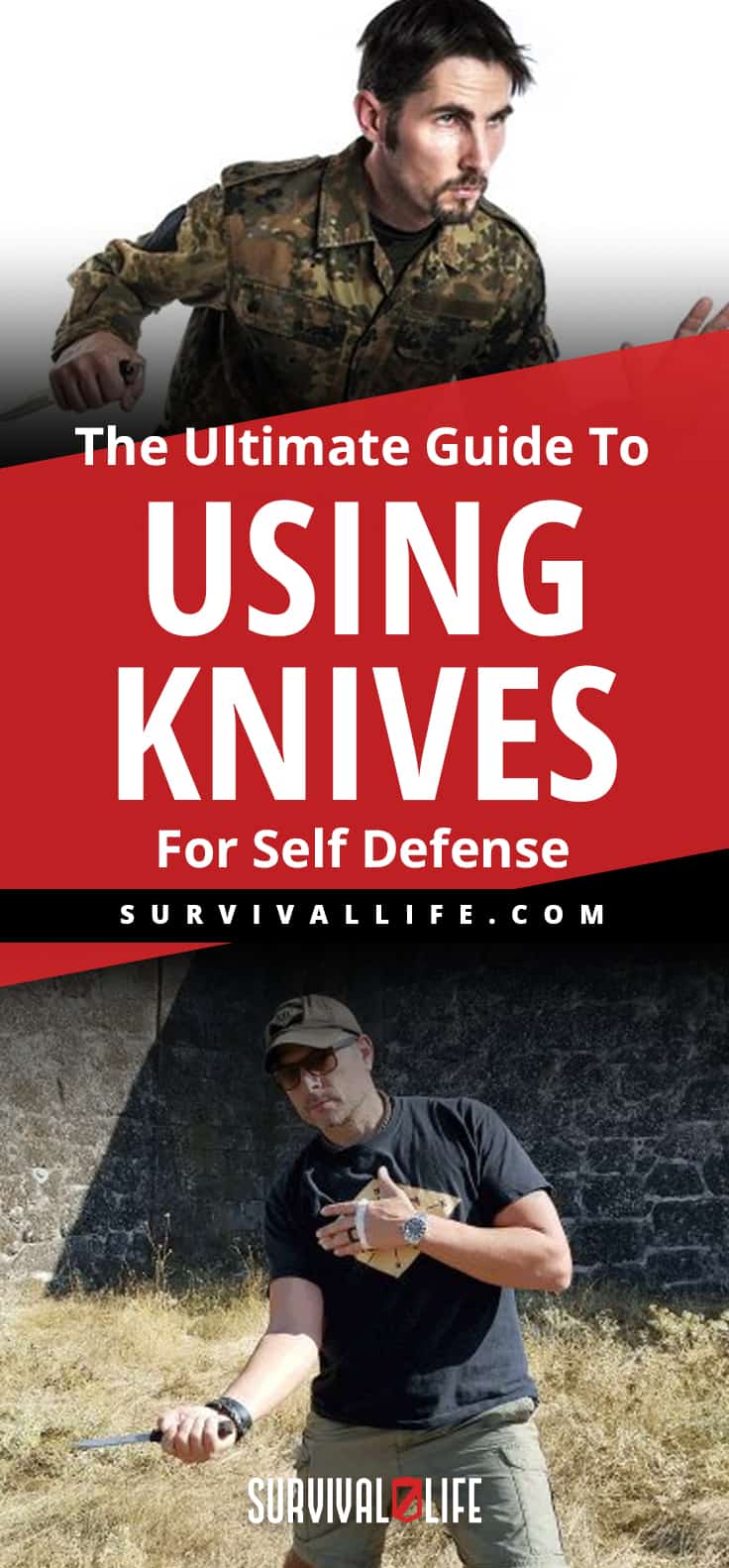Featured Articles
Using Knives For Self-Defense: What You Need To Know

Increase your skill with the blade and know how to use knives for self-defense here.
Knives for Self-Defense: Here’s Why
Defending Yourself with an Edged Weapon
What do you think about using knives for self-defense? There are a lot of talks these days about the importance of not only being able to use a knife offensively but also having the ability to defend yourself with the blade.
Even many of the traditional martial arts are implementing an edged weapon component to their curriculum. These days, all you need to do is turn on the news and you will see why a knife used in self-defense has become precedence.
Criminals and terrorists are not only attacking the general public with an edged weapon. They are also targeting law enforcement with machetes as well as other blades.
Experience with Knives
I was first exposed to various methods of knife training in the United States Marine Corps.
We practiced with bayonets as well as our Kabar TDI law enforcement knife. These were two of the blades that were standard issue and always out with us on the field.
We heard many war stories from our instructors about the value of being proficient with an edged weapon. Not only was it valid in trench warfare during World War I and II, but it has also been utilized by modern-day special forces fighting terrorism.
Once my active duty tour in the Marines was over, I continued my education on utilizing knives for self-defense. My focus was on FMA (Filipino Martial Arts) and other methods coming out of Eastern Europe.
Pulling movement patterns from both systems allowed me to gain a deeper understanding of how and when to deploy a blade during a combative situation.
There are many similarities to any good knife fighting system. Finding one you will stick to and practice often is the advice I give anyone who is beginning their training.
Please keep in mind there are no winners when it comes to most knife confrontations. Hollywood and even YouTube martial artists demonstrate applications that look amazing on video.
However, in real life, things are much messier and more devastating than what most people realize is the truth. One of my teachers explained it to me this way…
“In most knife fights there are two outcomes, one fighter goes to the hospital while the other goes to the morgue.”
Folding Knives or Fixed Blade Knives for Self-Defense
Just like most things in life, we all have different preferences and needs when it comes to the type of blade we choose to carry.
We have those who prefer tactical folding knives they can easily conceal in their pocket. There are others who feel the only true fighting knife is one that features a fixed blade.
The arguments on both sides are usually quite valid. However, there are laws and regulations, depending on your location, that will limit your choices to either one or the other.
I am currently based in New Jersey. Here, I am allowed to carry a folder as long as it meets certain specifications.
If I were to get in my car and drive just 40 minutes away to New York City, my folding knife would be illegal, but a fixed blade would be fine to carry.
My point here is we may not be able to carry our preferred blade, so it is always best to continually train with both types of knives.
How to Grip Knives for Self-Defense
There are two main grips when it comes to the knife. There is the forward grip and the reverse grip.
With the forward grip, the knife is usually tipped up. With the reverse grip, the opposite occurs and the tip is down.
There are different schools of thought as to which grip is best. It is true, we may have a preferred grip for wielding a knife but in a self-defense situation, that choice may not be available.

In an ideal scenario, you will be able to deploy your blade in your preferred grip. However, when SHTF during a combative encounter, your ideal grip may not be an option.
In a struggle, a blade may end up on the ground. When you retrieve that blade, it may be in either a reverse or forward grip.
Knowing we cannot always get to our ideal grip, it is imperative you train with both positions in mind.
RELATED: A Knife To A Gun Fight? Win With The Best Tactical Knives
Thinking About Your Range
There are four main ranges when it comes to combative applications with the knife. The varied ranges are:
- Close Range – Within this range, you can elbow, knee, and headbutt your attacker.
- Mid Range – At mid-range, your empty hand can touch your opponent during an encounter when fully extended.
- Long Range – In the long-range, your empty hand is unable to touch your opponent when extended.
- Floor or Wall – This last range comes into effect once one plane of motion is removed. This occurs when up against a wall or on the floor.
The way we attack and defend against the knife has a lot to do with the range we are in.
As an example, when I am in the mid-range, I will need to use my empty hand to “check” my opponent’s strike. If I do not, I will get cut during their follow-through with the knife because of our short distance from each other.
If we are in long range, there is no need to use my empty hand to check because my opponent will be too far from me to actually cause damage to my vitals.
Attacking with Eight Angles
When it comes to teaching offensive movement with a knife, there needs to be a certain language spoken by the teacher and the student. Instead of using complicated language to convey a movement, we use angles numbered from one to eight.
Some teachers choose to utilize more angles, while other instructors opt for less. Neither option is superior to the other, and it is completely up to the teacher’s discretion.
If we were to use our neckline as an example, a knife strike coming diagonally from the right would be called an angle one. A backhand coming to the right side of the neck on a diagonal will be an angle two.
Utilizing a simple number system not only simplifies the learning process, but it allows much less processing time to speed up their movements.
Defending Against the Eight Angles of Attack
In order to try and bode well for an attack, we need to implement a defensive strategy. I do believe that offense is your best defense in a knife encounter.
As we discussed earlier, the range you are operating in has a lot to do with your approach to defending an attack. If I am in mid and close range, the most popular distances when it comes to knife fights, I need to use my checking hand to stop the assailant’s momentum.
If my opponent were to throw an angle one, while in mid-range, I may be able to cut his arm by throwing my own angle one.
Even if I slice their arms open, the momentum of their strike will still continue toward my neck. If I do not use my empty hand to check or nullify his momentum, I will lose the battle.

Each angle has its own counter to defend against it. Nothing is ever foolproof, but what we are trying to do is increase our chances of getting out alive and going home to our families.
The more we practice from these angles, the better we will be fair in this unfortunate situation.
The Knife Alphabet
One way to develop good attributes with the knife is to mentally write out the alphabet utilizing your knife. Think about your opponent being directly in front of you as you trace the alphabet on his body.
Think of the tip of your knife as a ballpoint pen. You can then trace the letters in the air as you go through the whole alphabet.
Some of the patterns may feel a bit awkward, but it gives you a good reference point on which movements or angles feel the most comfortable for you. You can use both a forward and reverse grip for this exercise.
Once you feel proficient in tracing the letters of the alphabet in a static position, begin moving your feet around as you continue your practice. Tying your breath to the tracing of the alphabet and the movement of your feet will allow you to flow in an uninterrupted movement.
This takes continual and steady practice. If you devote the time, the dance begins to become a natural part of you.
Practice with Feedback
Free-flowing with your knife while only cutting through the air is a valuable practice. Once you feel comfortable with the dance, it is important to get feedback from the angles you throw.
In order to achieve this with solo practice, use a tree or heavy bag to throw your eight angles at. You will quickly notice you are getting completely different feedback than you were when you were just throwing your angles in the air.
During a self-defense application, you will have to actually, strike a target. The way your knife will react to that strike is something you need to learn to control.
Devoting plenty of time to practicing your angles, while receiving feedback, is imperative if you hope to bode well for the battle.
Practice with a Partner
Practicing your angles with a partner is one of the best knife defense methods for developing your skills. You will not only be getting direct feedback from a moving target, but you will also work both offensive and defensive applications of the knife.
It will be a rare moment if an attacker remains in a static position during an attack. Being able to move with him or her is crucial to utilizing knives for self-defense.
Just like most skill-building endeavors, adding a partner makes things a bit more fun. The motivation level tends to go up, and you also have each other as motivation for those days you do not feel like getting off the couch.
The more time you invest in training with your edged weapons, the more viable the blade becomes in real-world scenarios.
Bottom Line
I see many people carrying knives for self-defense. Unfortunately for them, the time devoted to training is usually, minimal, at best.
I tell newer students it is best to leave the knife at home if you choose not to practice with it. The knife has to be an extension of your natural movement.
When it is not, it is more of a liability than an asset to you. The “bad guys” are out there training to be malicious.
If you are not well versed with your knife, they can easily disarm you and use your own blade to cause your harm.
Watch this video of Coach Helder using a blade for self-defense:
As I mentioned earlier, there is rarely a good outcome when it comes to a knife encounter. We need to train to give ourselves a better chance to get home safely.
The world is getting a bit uglier each day. We need to prepare to not only keep ourselves safe but also to protect our loved ones.
Train with knives for self-defense as if your life depends on it because someday, it just might!
Tell us your own knowledge and experience with knives for self-defense. Share your thoughts in the comments section below!
Up Next: Are Switchblades Legal? Knife Laws By State
The contents of this article are for informational purposes only. Please read our full disclaimer.

Editor’s Note: This post was originally published in January 2018 and has been updated for quality and relevancy.
-

 Do It Yourself7 months ago
Do It Yourself7 months agoParacord Projects | 36 Cool Paracord Ideas For Your Paracord Survival Projects
-

 Do It Yourself9 months ago
Do It Yourself9 months agoHow To Make Paracord Survival Bracelets | DIY Survival Prepping
-

 Do It Yourself9 months ago
Do It Yourself9 months ago21 Home Remedies For Toothache Pain Relief
-

 Do It Yourself10 months ago
Do It Yourself10 months agoSurvival DIY: How To Melt Aluminum Cans For Casting
-

 Exports8 months ago
Exports8 months agoAre Switchblades Legal? Knife Laws By State


Grampa
January 7, 2018 at 10:39 AM
having grown up in Detroit where fighting with knives was a normal practice. it is the unknown factor of the desperate and unbalanced person you face. they can be enraged from many things. all of these factors pumping Adrenalin provide the reduction and reaction to pain. giving an advantage because even what can be fatal will keep someone going. while most of our fights has rules of first blood won the fight survival wont have such restrictions. your opponent wont stop until you are dead. you must have one rule.win and quickly. the longer the fight goes on the less chance you have of winning. while skill is a factor speed is another. your energy will drain quickly when it does your reaction time fades. while I do not think myself as skilled fighter I had the good fortune to have fights I could walk away from. strangely one of the people I fought with was a good friend later in life. even knowing what I know I would die quickly in Detroit now. today they use guns and life has little value and they will kill you. should you learn how to fight with a knife? Yes. In close quarters in a crowd just knowing how to use a knife is important knowing how to spot a threat is a close second thanks for reading my rambling rant.
Grampa
Kelly Fitzgerald
January 9, 2018 at 9:27 AM
Knives are far more dangerous and more lethal than a handgun shooting if the distance is withing 21ft. I would also point out that knives are very difficult to stop within a 21ft radius, if both parties have knives you are both going to get cut… end of conversation.
Don Oberloh
January 23, 2018 at 9:20 PM
I think you are referring to the old FBI film.., It against a LEO with a holstered weapon, not “HANDGUN SHOOTING.” Maybe don’t try to stop the knife, but stop the attacker.
Ralston Heath
January 10, 2018 at 8:13 AM
Let me say; Good Article. One of the better ones I have read on knife fighting.
One thing that you may want to add in a future article is the fact that the fight is not fair. There is no chivalry, rules, referee, or cheering crowd. There is no warning, no starting bell, and no time limit. You will be in a kill or get killed situation, so you must change your mindset from sportsman, to predator (never think like the victim/prey, as prey gets eaten).
Good first article on knives, looking forward to more.
R. C. Nelson
January 14, 2018 at 4:49 PM
Good article. Your eight angles all come directly from the eight parries of fencing with a sword, and the arm movements almost directly replace the sword in sword and dagger. I fenced and taught classical fencing (which is much different from modern style) for years till a knee injury, and everything you say is very familiar. In fact, if one is very interested in the subject, I’d recommend finding someone who can teach a person sword and dagger in order to learn the choreography–it’s very different than regular fencing with a single blade as the dagger is every bit as offensive a weapon as the sword. All this said, now that I’m old and slower than I used to be, I prefer to close range with open hands and inoffensive manner until within about six-seven feet and then draw a good OTF switchblade (e.g., a Benchmade Infidel or similar with 4″ or longer blade) that can be deployed reliably in a single motion while lunging on the jump forward and come from below to the solar plexus. This is REALLY tough to defend, and your opponent’s likeliest response will be to jump back or to the side, which will likely put him off balance, and you keep going, never letting him recover his balance–a man trying to find his feet is too distracted to properly defend himself. This is something I’ve used successfully multiple times in the past, and even works well if you’re both only using fists. The neck will be too well defended for a first cut, the chest and head are too bony for a reliable deep stab, and a hit to the gut like this will quickly take down even someone out to kill. After that you can decide what to do next at comparative leisure. The bottom line is to take him out as fast as possible with the least engagement possible. Just my two cents, and you’re free to disagree.
Mode und Fashion
May 30, 2018 at 3:59 PM
Schoene Webseite, ich komme mal wieder vorbei.
Pingback: The Ultimate Guide To Using Knives For Self Defense
Pingback: All You Need to Know About Pocket Knives For Everyday Survival | survivalisthandbook.com
Pingback: 7 Martial Arts For Self-Defense | Survival Life Personal Safety
Pingback: 7 Martial Arts For Self-Defense - Survive!
Pingback: All You Need to Know About Pocket Knives For Everyday Survival
Pingback: 3 Survival Knives You Need From Blade-Tech Industries – Danggle Markets
Pingback: The Ultimate Guide To Using Knives For Self-Defense | Primitive technology
Pingback: The Ultimate Guide To Using Knives For Self-Defense - Survival Patch
Pingback: The Ultimate Guide To Using Knives For Self-Defense | Life Off The Grid
Pingback: 3 Survival Knives You Need From Blade-Tech Industries | Survival Life
Pingback: 3 Survival Knives You Need From Blade-Tech Industries | Primitive technology
Pingback: 3 Survival Knives You Need From Blade-Tech Industries – Ultimate Survival Alerts
Pingback: Learning to use a knife for self-defense survivallife.com / ... - DIY Projects for Men
Pingback: 7 Self-Defense Video Techniques You Need To Know | Survival Life
Pingback: 5 Surprising Self Defense Tips To Crush Attackers – Bulletproof Survivors
Pingback: What You Need To Know - Les Recettes Savoureuses